iPod and essential mobile accessories
listening equipment review
Apple iPod 40GB
Griffin iTrip
Griffin iTrip LCD
Griffin RoadTrip
Griffin iTalk
Griffin AirClick USB
Griffin PowerPod
Vaja Cases iVod3G
Contour Designs Showcase
Booq PodPaqs
iSkin Exo2
iCleaner Pro
Apple iPod In-Ear Headphones
reviews © Musical Discoveries Staff 2003-2005Griffin iTrip
Griffin iTrip LCD
Griffin RoadTrip
Griffin iTalk
Griffin AirClick USB
Griffin PowerPod
Vaja Cases iVod3G
Contour Designs Showcase
Booq PodPaqs
iSkin Exo2
iCleaner Pro
Apple iPod In-Ear Headphones
images used with permission
post comments to our discussion board
last updated 25 November 2005
In September 2003 Musical Discoveries' editorial staff began the process of migrating away from using CDs and various players for listening to material we review. While the staff still prefer CDs for a myriad of reasons, especially the quality of the accompanying artwork and ultimate sound quality of playback equipment, the opportunity to carry a large selection of material in a small and lightweight digital package drew significant attention.
This article provides our insights into our mp3 jukebox experience thus far. Read our review of the Apple iPod, the Griffin iTrip, the Griffin PowerPod and reviews of several cases including the Vaja iVod, the stunning Countour Designs Showcase and two Booq PodPaq models. Internet resources on this subject are vast and this article is meant to share our experience to date and to fill in some blanks for newcomers and experienced users alike. We welcome your comments on the article either in our discussion board or site updates pages.
Buy High Quality Ceiling Speakers and other audio accessories available at NHThifi.com.
The Apple iPod
The premium portable music player is certainly Apple's iPod, a cigarette pack-size, hard disc-based music jukebox. On offer today are models in 10GB, 20GB and 40GB storage increments. The top two models are sold with a docking station, remote control and Apple-branded case as bonus items to the package. Ideal for the mobile individual, the iPod will perform its task on battery for about eight hours unassisted. Although airline power adapters are not available at this writing, the aftermarket has produced cigarette lighter plug adapters.
Accompanying the iPod until just recently has been the PC-based Music Match Jukebox player and iTunes for the Mac. Apple's iTunes was released for PCs in October 2003. Most iPod owners find iTunes far superior although not all MMJB features were included within it. The iPod requires an accompanying computer: either a Mac or a PC. The Mac connects via Firewire whilst the PC connects via USB-2. The accompanying software's primary functions are to manage the computer's music library, "rip" (convert) CDs to mp3 (or other formats) and to manage the transfer of the resulting compressed files to the iPod. The iPod supports other formats.
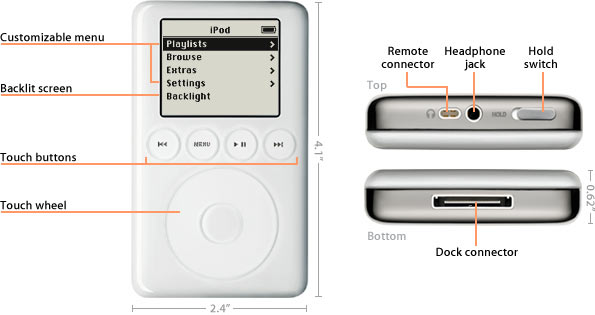
Image © Apple Computer Corp 2003
The most notable omission from iTunes is the automatic album cover grabber found in MMJB. While the feature will work with music purchased from the iTunes store, album covers from CDs that are ripped to the iPod must be dragged or copied and dropped into the player for inclusion in the resulting mp3 file. Otherwise iTunes is indeed far superior with a similar user interface to the iPod's and a much faster iPod connection and disconnection capability as compared to MMJB. A newer version of MMJB beyond that distributed with the latest iPods has a better look and feel but remains different enough from the iPod or Windows Media Player to be an unnecessary burden on the iPod owner.
We found both the MMJB and iTunes software installation straightforward and easy. Any experienced user should have a similar experience. The removal of MMJB manually even when the program is uninstalled. After the PC version of iTunes was released, MMJB began a campaign to win users back. While there are some reasons to return, experienced iPod users are tending to stick with iTunes. iTunes is a free download and MMJB licenses above the version supplied with the iPod will at least eventually require additional payment. iTunes is also the interface into Apple's iTunes store where most tracks can be purchased for $0.99 each and sampled for free.
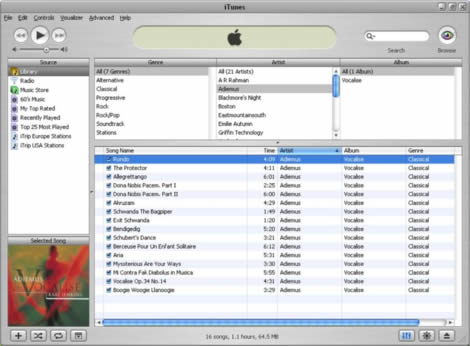
Image © Apple Computer Corp 2003
The iPod player is an extremely solid unit. The third generation product used by our staff uses just six touch sensitive controls on the face and a hold switch on the top as the user interface. A touch sensitive scroll wheel that is used to navigate the menus and the small LCD are the centrepiece of the design. Menus are easily followed and navigated with the scroll wheel and button in its centre. An audible "clicker" can be enabled to heighten the experience.
The front of the iPod is actually a clear cover to the white surface beneath except in the area of the LCD. Cutouts in the clear cover provide access to the four control buttons and scrollwheel; the clear cover actually continues on the select button that resides in the centre of the scrollwheel. Height and width dimensions of all third generation iPods are the same; the earlier 30GB and current 40GB model are slightly larger. The majority of the sides and all of the back of the unit are mirrored silver and quite prone to finger prints, the only annoyance of the otherwise stunning mechanical package.
The iPod is comprised of a hard disc drive, battery, electronics and user interface. The packaging of these components has been well honed and by this third generation they appear flawless. The unit will accept firmware updates from control software that is installed on your base computer. While these downloads are meant to be fault free, a version released last month had an undesired result on one staff member's 15 GB iPod. It is a good time to break and speak of Apple's after sales support.
Should the iPod have a failure within the warrantee period, Apple will open a case with their support division and send by express courier a box and instructions to return the device to them at no charge to the customer. The box will typically arrive the next day. It is specially configured for the iPod and includes everything needed to return it by the express company to Apple. Turnaround can be very quick. Our experience had the unit back within only a couple of days allegedly repaired. Regrettably the problem persisted and the process had to be repeated. The unit was subsequently replaced with a new unit and upgraded to the 20GB model as compensation for an error the first time around. It is best to draw your own conclusions on the service experience.
The iPod can replace a myriad devices in your music playing life if you allow it to do so. Convert your music to mp3 on your home computer. You can use CD, cassette, 8-track, LP and other sources as input, but iTunes will only accept CD or other music files as inputs. Use other products to convert other audio sources. The ripping process for the average CD album, depending on your computer hardware should complete in about five minutes. Transfer to the iPod is typically not longer than a few seconds on USB-2. You can also download mp3 files from the internet and migrate them into iTunes for use on the iPod. Then navigate through your library with the highly intuitive and configurable user interface.
The device has a lineout capability through the dock but otherwise is designed to play through headphones. There's plenty of volume available. While we have listened with the provided high quality (Sennheiser) bud earphones, we listen most of the time using Bose QuietComfort 2 headphones. The acoustic result with these headphones surpasses the buds by miles.
The mechanical design of the unit and accompanying accessories is superb. Users will be impressed with the small but effectively sized dock, cables and wall power adapter. Mac users enjoy the ability to recharge their iPod over Firewire connected to their PCs. PC users need to purchase the optional USB cable from Apple or a Firewire card for their computers. Most appear to opt for the USB cable. The Firewire cable that accompanies the unit can be used with the wall power adapter and Griffen PowerPod to charge the iPod. And the well designed wall power adapter has interchangable plugs; that is, there is a world power accessory with alternative plugs for the device available from Apple.
From our first week with it, the iPod proved to be easy to use and an essential component in our mobile lifestyle. We found time to rip CDs and download mp3s to it and to keep it organised. We also upgraded from MMJB to iTunes and within a week upgraded both iTunes and the firmware on our 40GB player. We've now got over forty albums loaded on the iPod and find sound, accessibility and flexibility to be wonderful. Of course this was around the home and on the airplane--but what else could we do?
Further Information. Interested visitors should browse
 www.ipoding.com, a robust
source of inspiration for all iPod enthusiasts. The technically oriented site called
www.ipodhack.com is also worth a
visit. Read further reviews, check out online specials and order the iPod from amazon.com
here.
www.ipoding.com, a robust
source of inspiration for all iPod enthusiasts. The technically oriented site called
www.ipodhack.com is also worth a
visit. Read further reviews, check out online specials and order the iPod from amazon.com
here.
The Griffin iTrip
The idea of making road journeys without a stack of CDs was brought to light when we discovered the Griffin iTrip. This device, only slightly thicker than a penlight battery and about the size of your pinky finger, plugs into the remote control and headphone sockets on the top of the 3G iPod. A first offering is available for earlier generation iPods. The iTrip accepts audio from the iPod and modulates it on an FM signal that can be played on any compatible receiver, just like those found in automobiles, boats and your home. And it does so wirelessly.
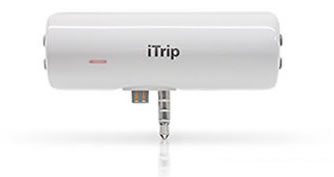
Image © Griffin Technology 2003
The concept is great and at an attractive price, most enthusiasts will wonder how they ever got along without it. Indeed, that has been our experience. The sound is typical of FM radio; certainly no better and not really any worse. The key is to select the right frequency for your area and to play the iPod at enough volume (with EQ set for your personal preference) to maximise the quality of the experience. However the convenience is unbeatable.
Plug the iTrip into the top of the iPod. Select the playlist for either US radio stations or European radio stations made on your computer with the Griffin supplied CD and downloaded to your iPod. Or just use the default of 87.9Mhz if that frequency is clear in your area. The iTrip's led will flash and then lock to show the frequency has been accepted either when the frequency is changed or the music plays. And then just play the iPod. It is that simple. Well almost.
The frequencies on the Griffin CD are each short audio tracks. The best way to manage them and the iTrip device involve loading them into a playlist. Load the playlist onto the iPod. Then bring it up first, find the frequency you want and play it until the LED on the iTrip locks. Then return to the menu and pick your music. And then just play it. While some may complain about sound quality, it is not bad at all. Any quality degradation is far overcome by the convenience offerred by this wonderfully engineered device. Fit and finish is good. Griffin have attempted to achieve the same standard as the iPod. They have come close but the iPod's construction is still superior.
 Read further reviews and order the iTrip from amazon.com
here.
A great addition to your 3G iPod, the well-made iTrip is an essential for mobile
listening.
Read further reviews and order the iTrip from amazon.com
here.
A great addition to your 3G iPod, the well-made iTrip is an essential for mobile
listening.
The Griffin iTrip LCD
Unlike previous iTrip models that required that special tones--stored as mp3 files on the iPod--to be used to change broadcast channels, the iTrip LCD is tuned with a knob, just like a radio. With more than just improved controls, the newest iTrip is just slightly bigger than the previous model for full-sized iPods. This one bears a good-sized LCD on the left side of the device and a silver control knob on the right. The knob acts both as a dial and as a button. To tune in a station, just plug the iTrip LCD into a dock-connector iPod's headphone and remote ports, start the iPod playing. Then turn the control knob until the LCD displays the station desired, and press the knob to lock in the station.
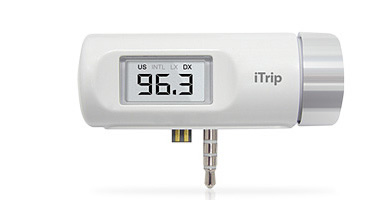
Image © Griffin Technology 2005
The iTrip's LCD lights up when you twist the control knob, making it easy to see what youíre doing even under poorly lit conditions. Shortly after turning the knob, the display dims. The LCD continues to display the currently selected channel as long as the iPod is awake. When the iPod goes to sleep, the display disappears as well. When the iPod awakens, the display won't appear again until the iPod is started.
The iTrip LCD also welcomes so new features. To begin with, it can transmit in either LX or DX mode. In LX mode, the iTrip transmits in stereo. DX mode switches the iTrip to a stronger mono signal. Some audio content sounds almost identical in mono or stereo. Since DX mode produces a stronger, clearer signal, it should be used when the iPod is some distance away from the receiver.
The iTrip will attempt to automatically set the optimal volume. However, for some high volume content, the adjust the iPod's volume should be adjusted to a lower level to prevent distortion. For most audio content, an easy way to set volume levels is to turn the iPod all the way up and let the iTrip adjust its output level and then adjust the volume on your receiver to a comfortable listening level.
The new iTrip LCD is impressive. It offers reasonable range in LX mode and outstanding range when launched into DX mode. Its controls are intuitive. One should consider using the iTrip with an auto power adapter during long raod trips since the iTrip LCD uses the iPod's battery as its power source.
 Read further reviews and order the RoadTrip from amazon.com
here.
A great addition to your 3-4G iPod, the well-made iTrip LCD is an essential for mobile listening.
Read further reviews and order the RoadTrip from amazon.com
here.
A great addition to your 3-4G iPod, the well-made iTrip LCD is an essential for mobile listening.
The Griffin RoadTrip
The Griffin RoadTrip makes enjoying an iPod or iPod mini in the car convenient and easy. The RoadTrip plugs into any auto power outlet or lighter adapter and provides an adjustable cradle to charge and hold any docking iPod, including the 4G iPods and the iPod mini. The RoadTrip now ships with an adapter to hold the nano and 5G iPods. The RoadTrip transmitter can then be set to broadcast the iPodís music to any FM frequency from 88.1 to 107.9. Its backlit screen shows which frequency RoadTrip is currently broadcasting on and this can be easily adjusted via buttons located directly on the front of the unit. It is perfect for long car journeys.
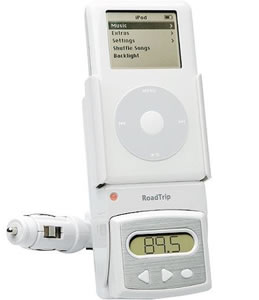
Image © Griffin Technology 2005
The audio signal is transmitted through the connected dock at the bottom of your iPod. Not only does this produce a superior signal but it also leaves the top of the iPod exposed for use with other iPod accessories.
The RoadTrip is a great all-in-one connection for the iPod in the car, but what makes RoadTrip truly unique is its removable transmitter that can also broadcast music from a Mac or PC. The package includes a combination USB power and audio connector cable that attaches any USB equipped computer to the module. Users can then play their iTunes music, movie audio or presentation sound to any FM stereo close by. The broadcast frequency can still be adjusted to play to 88.1 through 107.9 just as it can in the car.
When it comes to sound quality, all it takes is a couple of seconds to find a good frequency to listen to iPod tunes with zero static and CD audio quality. Itís a great alternative to radio. The RoadTrip is compatible with all docking iPods, including the iPod mini. However, iPods with FireWire ports on top (1st and 2nd gen) will not work with the RoadTrip.
 Read further reviews and order the RoadTrip at amazon.com
here.
Another great addition to your 3-4G iPod, the well-made RoadTrip is another essential for mobile listening.
Read further reviews and order the RoadTrip at amazon.com
here.
Another great addition to your 3-4G iPod, the well-made RoadTrip is another essential for mobile listening.
The Griffin iTalk
If you thought your iPod was just an MP3 player, you are in for a surprise. Plug the Griffin iTalk into the top of your iPod and suddenly you have a world-class voice recorder with literally thousands of hours of recording time. Record voice memos, interviews, meetings and other narrowband signals. You can do so up to 100 feet away. iTalk has a built-in microphone designed to record crystal-clear audio, and its Automatic Gain Control assures you have the best possible signal level for recording. Connect an external microphone, or headphones directly to iTalk for more recording and playback options.
The built-in speaker is amazingly loud for its size; you can clearly hear it across an office. And it sounds great. In fact, you can use iTalk as a mini-speaker system for your iPod. You'll never realize how much you've missed a built-in speaker until you have one. iTalk can play recordings through its integrated speaker, or through headphones. It includes a pass-through headphone jack so you can monitor your voice recording or listen to your music without removing iTalk.
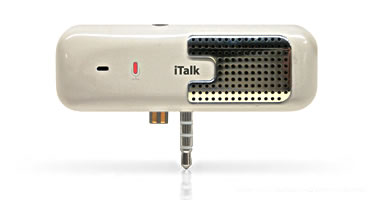
Image © Griffin Technology 2004
Like the iTrip, the concept is great and at an attractive price, most enthusiasts will wonder how they ever got along without it. It is the same width as the iPod and just as thick as the 20GB model. Indeed, that has been our experience. Recording quality is decent and with both the passthrough audio connector and built-in speaker, playback is a cinch. It's not clear that the iTalk works well from a distance, especially in situations where there is a lot of background noise.
Again, like the iTrip, plug the iTalk into the top of the iPod. The iPod recognises that memo recorder hardware is plugged in and the iPod's firmware takes over. The iTalk's led will light up to show that it's been recognised by the firmware and is engaged. And then just use the iPod's firmware through the standard user interface. Simple.
Sound quality is suitable for both memos and interviews, the primary function we use it for. Any quality degradation over a traditional tape or digital recorder is far overcome by the convenience offerred by this wonderfully engineered device. Fit and finish is excellent. Griffin have again achieved the same standard as the iPod.
 Read further reviews and order the iTalk from amazon.com
here.
A great addition to your 3G iPod, the well-made iTalk is an essential for
voice memo recording or interviewing.
Read further reviews and order the iTalk from amazon.com
here.
A great addition to your 3G iPod, the well-made iTalk is an essential for
voice memo recording or interviewing.
The Griffin AirClick USB
Griffin came up with another useful solution to controlling some Apple products without having to click your mouse or use the scroll wheel on your iPod. The premise is that you snap a relatively small USB adapter into your computer, install some packaged software, and a remote controls iTunes -- remotely. The AirClick is basically a small remote designed to wirelessly skip through the active library in iTunes (it will play through your iPod if you start it playing in your iPod's song list, or similarly a networked play list).
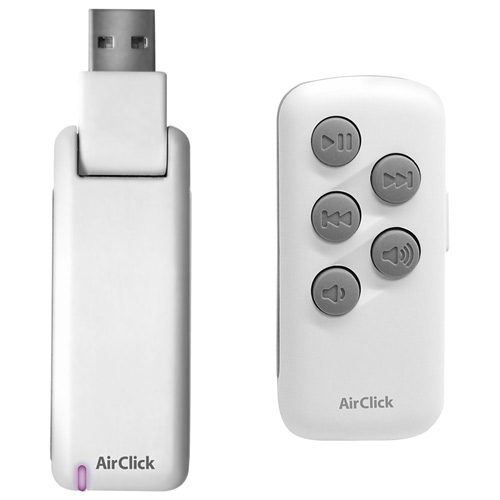
Image © Griffin Technology 2003
Griffin managed to keep the AirClick really simple - it's got the basic amenities like play/pause, skip forward, skip backward and volume controls. There's a hold switch that simply stops the remote buttons from doing anything, and if you hold the skip buttons down they seek rather than skip. Since there's a seek feature there's a small delay when skipping songs (to account for attempted seeking) and those who are not so quick when releasing the buttons may find themselves accidentally seeking rather than skipping. The bulk of the AirClick's functionality resides not in the remote, but instead in the minimal software package that ships with the product.
The software that Griffin provides installs very easily and runs just as well, but don't expect it to add much functionality. It provides an easy-to-use interface for selecting whether you'd like to use iTunes, Windows Media Player, or PowerPoint as the software to be affected by all your button pushing, but there's a few small caveats. If you select iTunes and iTunes isn't open, pressing buttons doesn't do much, WMP on the other hand will open for you, and PowerPoint behaves much as you expect--it doesn't react unless you open a slideshow of some sort.
Another interesting feature Griffin decided to include is to display a handy notification of what button you just pressed as an overlay on your screen. Now, this screen comes up no matter what you do, and it goes away after a short time (approx. one second), but there's no way to turn it off. If you click on anything while the display is up your clicks respond as you'd expect, but the screen doesn't go away. The application will always run in the tray, and there's no exit button, though nothing is really active unless the USB adapter is plugged in. One last issue occurs only with iTunes--when closing iTunes the user receives a handy alert that there's an application using its scripting interface and that it will close in 20 seconds or by the click of your mouse. Not that this is unexpected, but even if iTunes is not the target of the AirClick software's button pushes this alert still pops up.
Don't take all these software complaints the wrong way, the hardware is very reliable, and the software operates just fine as long as you don't want to close iTunes or automatically open it. The AirClick is a great product, the software that ships with it seems to be slightly lacking and immature but expect Griffin to release updates that resolve some of these "issues" and maybe add functionality or features. The AirClick is definitely a device to own and is well worth the the money for its ease of use and reliability. With some time to mature the associated software this device will make an invaluable remote-control tool for those looking to move away from their computer and listen to music from afar.
 Read further reviews and order the AirClick USB at amazon.com
here. The AirClick USB is a great addition to USB-equipped laptop and desktop PCs running iTunes.
Read further reviews and order the AirClick USB at amazon.com
here. The AirClick USB is a great addition to USB-equipped laptop and desktop PCs running iTunes.
The Griffin PowerPod
This great little device is a cigarette lighter adapter that produces an iPod compatible power signal on the firewire cable that is part of the 3G iPod package. Most impressive is the innovation of using the existing cable rather than introducing yet another.
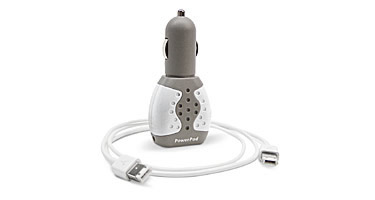
Image © Griffin Technology 2003
Fit and finish is good, like the iTrip, maybe a bit better. The device is neither too big nor too small and it's plenty rugged, a good thing for road warrior compatibility. Griffin, like with the iTrip, have gone to the trouble of offering it in Apple lookalike packaging as well. A nice touch.
 Read further reviews and order the PowerPod from amazon.com
here.
A great addition to your iPod, the precision quality of the PowerPod makes it another essential for
mobile listening.
Read further reviews and order the PowerPod from amazon.com
here.
A great addition to your iPod, the precision quality of the PowerPod makes it another essential for
mobile listening.
The iPod Cases
Standard Apple 3G iPod Case and Sack. The larger size 3G iPods are all acommpanied by an Apple case and storage sack. It is perfectly suitable protection for a user's initial experimentation with the device but is limited in its accessibility to the controls and display. The controls can be overcome by the remote but the hidden display is somewhat troublesome. The case includes a beltclip that some users do not need. Ultimate protection requires use of the case and the storage sack together as a system.
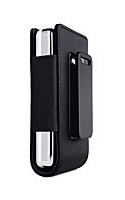
Image © Apple Computer Corp 2003
A major benefit of the Apple-branded case is that it will almost certainly not scratch the iPod. And if for no other reason, it should be used to prevent scratches to the treasure. Coated with nylon, slightly padded and with belt-clip, it's a perfect starting place for many and likely a good ending place for a good number as well.
Those that want to try something different will find the internet with plenty of alternatives. Read about two of them below.
Vaja Cases iVod3G.
Our first experiment with an aftermarket case was the iVod3G from Vaja Cases in Argentina. The iVod is a caterina leather covered plastic body case designed to protect the iPod more or less all the time. The iPod can not be docked although the access point will permit the player to be connected to the cable. While these cases look extremely attractive and easy to use on the internet--especially with the high quality digital photography used to illustrate them in various custom combinations of colours and from different vantage points--our case proved to be a bit of a challenge until we mastered the extremely tricky insertion and removal process.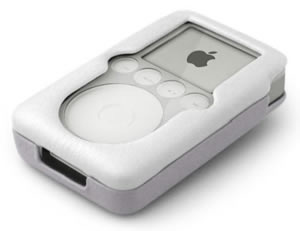
Image © Vaja Corp 2003
The leather work is lovely but the nylon liner craftmanship could be improved. The fit is very tight and, as mentioned above, one must be very careful when inserting and removing the iPod to avoid scratching the player with the well-machined clear plastic screen protector or the cut edges of the case's nylon liner. Marks can only be avoided by judicious maneuvering of the iPod, squeezing the sides of the case and angling the player to minimise contact with the case interior. To our surprise, the case construction forces a 1/8" gap from the bottom of the iPod to the case edge. Why the iPod does not go further into the case remains a mystery to us. Although the fit is tight, the iPod must be held in place when inserting the cable to the docking connector on the bottom of the iPod.
Clearly the Vaja iVod3G is the one of the classiest cases on the market but the plusses and minuses ahve to be carefully considered. The risk of scratching the iPod during insertion and removal of the player is excessive so the care required to manage these maneuvers and the high retail price--about double the best of the others generally available--make this case a specialty item best suited for the most attentive consumer. While the exposure of the iPod's top edge presents a somewhat undesirable risk, the ability to use the iTrip while the iPod is in the case is a plus. The case can be obtained at a small number of retail outlets but is best ordered from the Vaja Cases website.
Contour Designs Showcase.
The newest and most robust iPod case comes from Contour Designs, a company that has a heritage associated with producing aftermarket Apple accessories. The Showcase is the latest in the company's series of iPod compatible cases. It is a hinged model made of injection molded plastic designed to fit the 40GB model precisely. A foam insert is supplied for use with thinner model iPods. The insert is made of shock-absorbing foam. It has a non-scratch surface that acts as a cushion rather than just a spacer. The case was relaunched in various colors during the spring of 2004.The Showcase was designed and manufactured by Contour Design, Inc. in the US Headquarters. The case was designed by the same team that designed the award-winning iSee case. The iSee is still available for Apple's 1st and 2nd generation iPods. The iSee was a completely clear design that allowed the full iPod to be visible in the case. The Showcase was designed and built off the same principles as the iSee, however, dual-injection technology allowed for a smooth shock-absorbing rubber edge with a crystal clear front. This not only adds to the protection, but places the iPod in a newer, sleeker case. The cases are manufactured in Contour Designs' Taipai, Taiwan location.
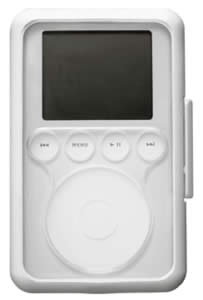
Image © Contour Designs 2003
The case has a clear hard plastic inner core, a white molded rubberized outer jacket and a precison plastic latch. The anchors for outer jacket--six on the top half and six more on the bottom--penetrate through slots of the inner core just enough to provide the cushion required to hold the ipod snugly in the case. The fit and alignment to the iPod's controls are absolutely perfect. Both the front of the case and the back sport clear windows to show off the iPod inside. An ingenious latch makes the belt clip (not illustrated here) adjustable and detachable. The case is extremely easy to use, especially when compared to sleeve-style alternatives. Damage to the iPod on insertion and removal is not an option.
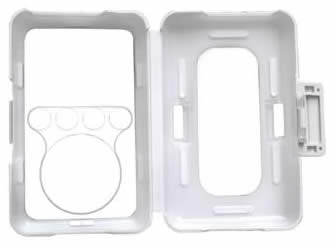
click on image for more information
Image © Contour Designs 2003
As can be seen from the illustrations, the case is only slightly larger than the 40GB iPod. In fact, the case is no larger than the compact sleeve style iVod3G illustrated above. Not shown here, but illustrated at the manufacturer's website, are the precision access portals for the docking, headphone and remote connectors and the hold switch. Innovation in both protective and aesthetic aspects has resulted in a truly superb design. The production and material quality is equally excellent. With the rubberized exterior and hard plastic interior and built-in shock protection, the Showcase is extremely good value for money.
The only shortcoming in our application is the inability to use the iTrip when the iPod is in the Showcase. Perhaps a future model will expand the top access point to permit the iTrip and Showcase to be used simultaneously.
The Showcase is highly recommended to all iPod users. Click on either of the illustrations to visit the manufacturer's website where the product can be ordered online.
Booq PodPaq014. The Booq PodPaq cases are well made products each comprised of a sleeve with a detachable front cover. This case sports a rugged ballistic nylon exterior with neoprine side panels. Nappa leather trims the edges and lines the rear of the sleeve. The front panel attaches via snaps on the back of the sleeve and features precision magnetic closures on the front.
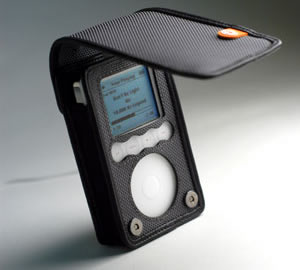 |
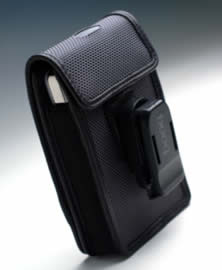 | |
|
Image © Booq Bags 2003 | ||
Advertised as designed for the 3G 10GB to 30GB iPods, the case will also tolerate the 40GB model under normal circumstances. A neoprine accessory sleeve inside the front cover is suitable for the bud headphones, but the case will likely only close with them inside when used with the thinner iPod models. A robust and beefy, mobile phone case-style, detachable belt clip is included. When the clip is detached, its modest plastic attachment point remains on the sleeve.
Cutouts for major controls on the front of the sleeve are precision. Booq has done an excellent job on both cases with access to the iPod's main controls. On this case only, they included a soft clear plastic window to protect the iPod's display. While the cutout on the top of the front cover for headphones and remote is perfectly aligned, the one on the bottom for the docking connector of our review model is too far to the back, at least for the 40GB iPod we tested with it initially. The fit on our associate's 20GB iPod was a bit loose, much like the PodPaqnappa's fit on the 40 GB model. The docking connector is equally misaligned for the 10-20GB iPods as well. This is the only--and minor--complaint we have about the case. Indeed it is a nice case and certainly a step up from many of the other cases on the market.
Booq PodPaqnappa. The latest iPod case from Booq builds upon the success of the ballistic nylon version but differs in several significant ways. First, the sleeve, while the packaging says the item is designed for the 10GB to 30GB iPods, it is much deeper and has obviously been designed for the 40GB model. There is actually room to spare. Rather than being trimmed out in Nappa leather, the entire case is carefully made and lined entirely of the material, except as noted below.
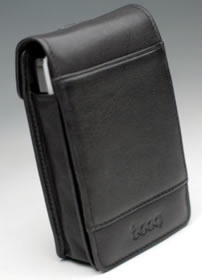 |
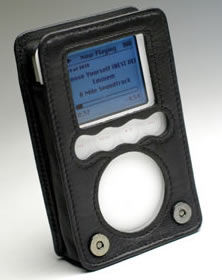 | |
|
Image © Booq Bags 2003 | ||
Like the ballistic nylon product, the case has a removable front cover. It attaches to the sleeve with snaps and has precision magnetic closures on the front. An accessory slot in the front cover provides storage for bud headphones. A second neoprine accessory sleeve on the inside of the front cover is also provided. The integrated eyeglass case-style belt clip is not as robust as the PodPaq14 and regrettably is not detachable--a drawback. Unlike the ballistic nylon version and the other cases reviewed here, the case has no intrinsic protection for the iPod's display when the front cover is detached, like when the iTrip is used in conjunction with the iPod.
Cutouts for the iPod's controls and docking connector are precisely engineered into the sleeve. The slot for access to the headphone jack in the cover is worth noting. The exterior is presented as an oval while the interior is a slit. Ingenious if designed to do so, it provides required access for the user while the case is closed while protecting the top of the iPod. The mismatch of exterior and interior openings does however look like a design mistake; perhaps a clever one. The PodPaqNappa is a premium case, well made of superior materials. Like the ballistic nylon version, it has a lifetime warranty.
iSkin Exo2. The latest offering from iSkin (Toronto, Ontario, Canada) is called the Exo2. Like the company's earlier products, the case is 100% silicon and could best be described as a glove. The kit comes with removable belt clip, hard plastic screen cover and wrist strap. A clear soft plastic water resistant zippered case is also included. Our review model is sonic (brilliant blue) and fits our 40GB iPod.
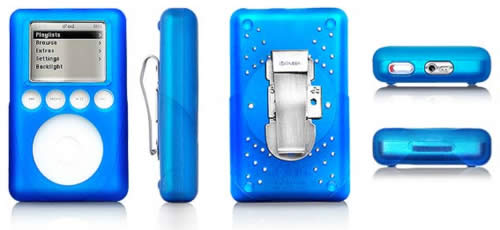 click on image for more information Image © iSkin Inc. 2003 |
The Exo2 sports features that will appeal to many iPod owners. The fit is excellent, so excellent in fact that once the iPod has successfully been inserted, many users won't want to remove it. The iPod is installed by inserting it through the screen opening. Once the fit has beed adjusted, the hard plastic screen cover is inserted to complete the installation. Cutouts for the controls are beveled nicely and a built in docking connector cover may be inserted to protect the contacts.
The back of the case as shown in the illustration has been designed to improve heat dissipation. There are ventilation holes and bumps in the silicon to aid conductivity. The clip is a two piece mechanism. When used the metal insert is placed at the back of the case with the clip's attachment points left protruding through the silicon. A latching mechanism is used to fasten the clip to these attachment points. We did not use the clip when reviewing the case. It was just too fiddly.
This case is unlike any of the others reviewed above. While it offers suitable protection to the iPod in many ways, like the Contour Designs model, it is not possible to use the iTrip at the same time which limits the usefulness of the case in our application. However the major drawback of this glove is the hard plastic screen cover. While it does the job, it has a prominent iSkin logo in the upper left hand corner and is "cheap" compared to the rest of the case. The belt clip is substantially flimsier than the Booq PodPaq14, the one available for the Vaja iVod and the Apple OEM case. But the sleeve fits great, is made very well, comes in great colors and offers good protection.
iCleaner Pro
iCleaner Pro includes one of the most advanced polishes on the market. It is so powerful that it will remove the scratches and swirls from the metal back of your iPod without harming the laser engraving and will even get deep scratches out off the white plastic surfaces. Our review kit included the entire iCleaner product line. Included were a 1 Fl oz Bottle iCleaner, a 1 Fl oz Bottle if iPod Maintenance Polish, a 1/4 oz Metal and Deep Scratch Polish, a 100 % Cotton Towel and an iCleaner 6"x6" Super Cloth, a synthetic non-abrasive Micro Fiber polishing cloth, that can be used to achive the best results with the various polishes. A plastic glove is provided to use the Metal and Deep Scratch Polish as well. While the kit comes with abbreviated instructions, a comprehsive set of guidelines are available online.
 |
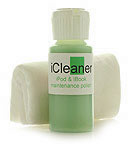 | |
|
Image © iCleaner 2003 | ||
We were a little skeptical before attempting to use the kit. Before we attempted using any of the products on the iPod we tried it out on some other similarly sensitive electronic products, most notably our Nokia cellphone, whose screen had a rather prominent scratch before polishing. We used the iPod scratch remover and the terry polishing cloth for the job. The instructions were followed and the product worked exactly as advertised and has earned our complete respect.
The iCleaner Maintenance Polish has been developed to remove very fine or light scratches out off the white plastic surfaces of the iPod. Itr is perfect for very new iPod's that have very fine or minor scratches. We tried it on some surface scratches in the white acrylic on the front of our 40GB iPod and achieved superb results.
The iCleaner Pro is a great kit and is offerred at the company's website for a very reasonable price. Certainly a must have for all iPod owners, it should be ordered ahead of the need and kept on hand.
Apple iPod In-Ear Headphones
The Apple branded iPod in-ear headphones are a welcome addition to the company's portable music product line. With a comfortable fit they provide a fair decrease in ambient sound as well as ample bass feedback--especially so for earbud headphones. Unlike the earbud headphones that ship with the iPod they sit inside the ear canal, not just in the outer ear. While this might ordinarily seem uncomfortable Apple seem to have engineered a proper solution to ensuring the fit of their product.
 |
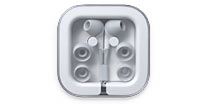 | |
|
Image © Apple Computer Corp 2004 | ||
Besides the typical Apple-esque packaging and finesse, the headphones come with three easily interchangeable sizes of rubber inserts to ensure a comfortable fit. The headphones come with a case that has space for the headphones and is engineered to allow the cord to wrap around the outside. While some users will return the headphones to the case after each use, the process caters more to a longer-term storage solution than the quick drop-them-in-your-pocket technique that most are familiar with from the earbuds.
The typical design advantages with most Apple products are abundant including the signature white-color to the precision printed L and R on each of the earphones. A small slider allows the wearer to adjust the separation of the earphones--not necessarily needed, but certainly welcome. Contrary to other reviews, our testers didn't find the wires clingy or prone to entanglement.
There's excellent fidelity across the entire range of high and low notes. The sound quality is far superior to the stock earbuds that Apple ships with their iPod. One problem that Apple didn't seem to overcome is that when the wires rustle, the sound is transmitted up the wire to the earphone. Although initially disturbing, our testers grew immune to the annoyance over time.
Return to website contents